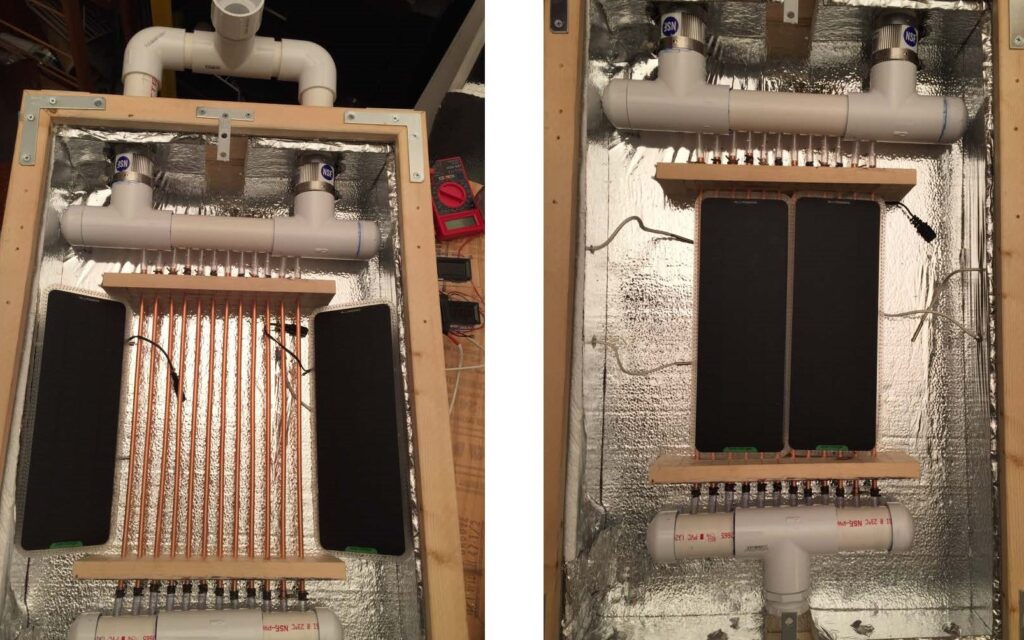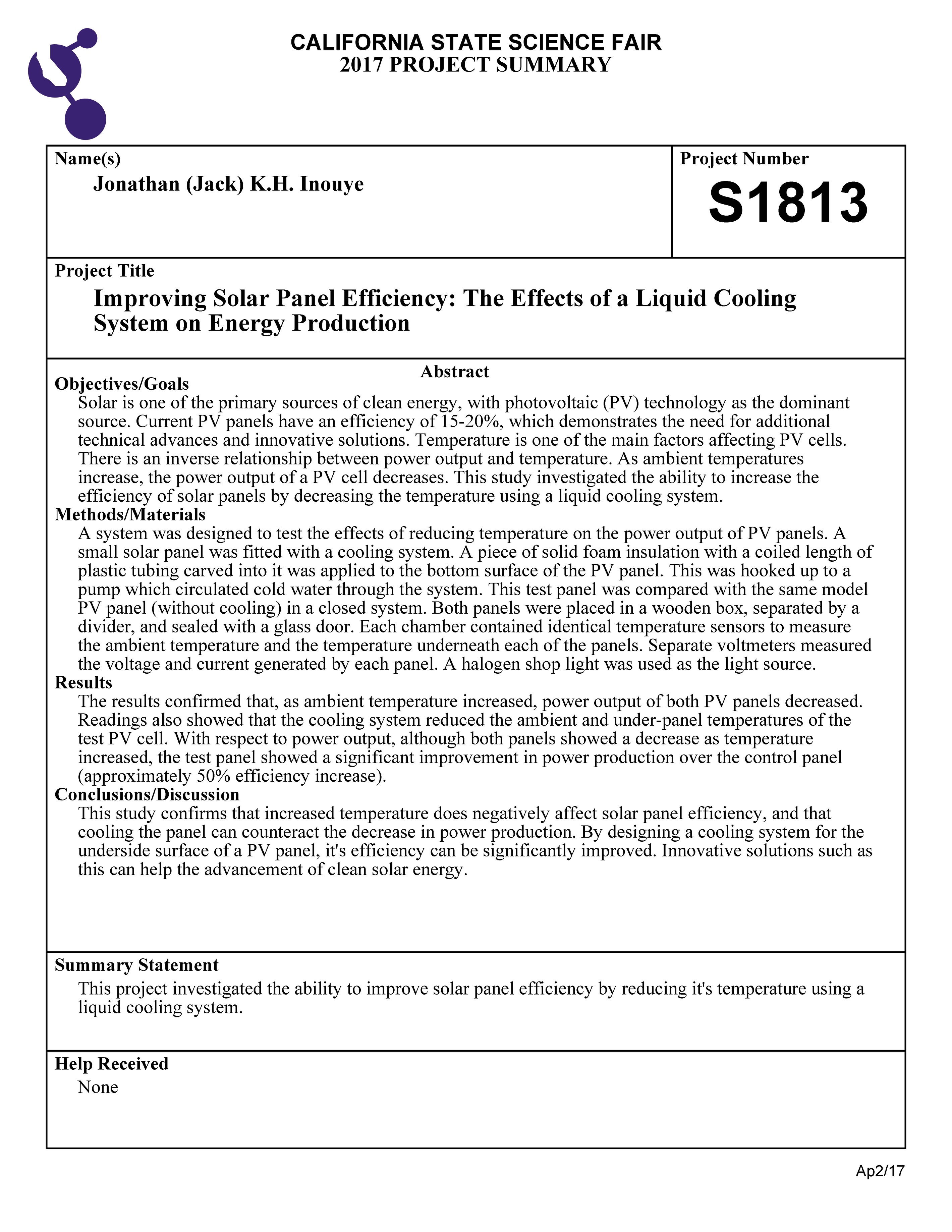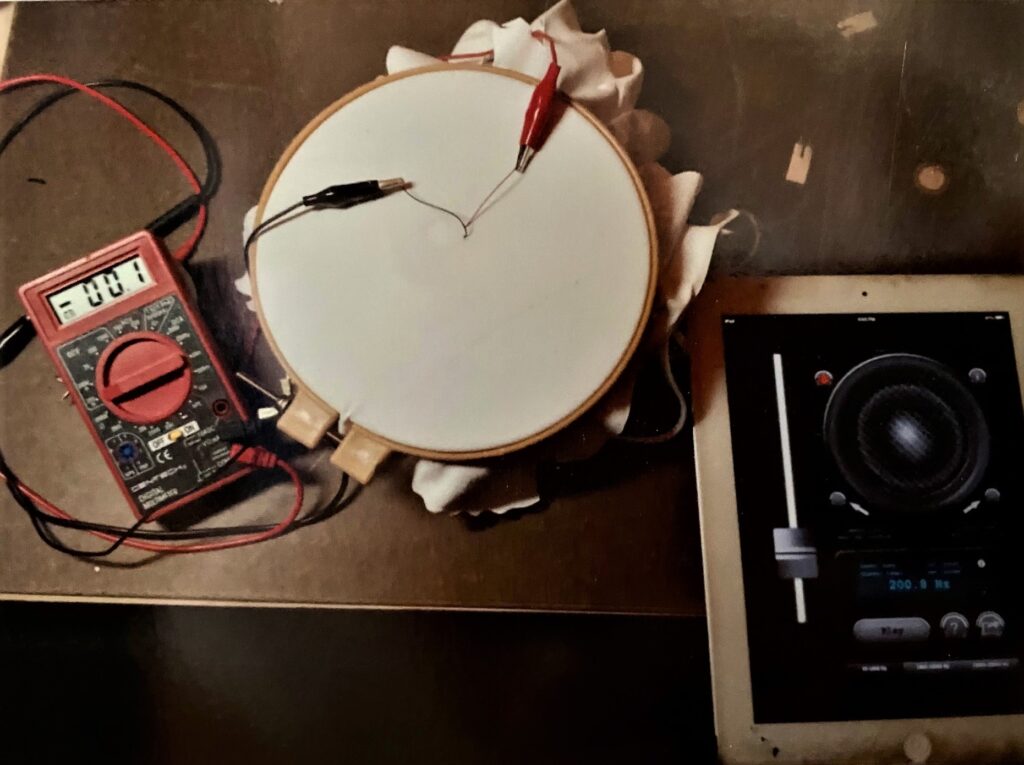What I Did
I participated in Regional and State Science Fair for several years, and all of my projects had to do with alternative energy. Most of my research focused on solar panels and increasing their efficiency. Below are photos and summaries of each project.
Improving Solar Panel Efficiency with Thermoelectric Generator Units Using the Seebeck and Peltier Effects
In previous years, I showed that solar panel efficiency decreases with increased temperature. The purpose of this project was to try and convert the wasted heat energy from a solar panel into usable energy through the addition of a thermoelectric generator (TEG). Through the Seebeck effect, a TEG can convert a temperature differential directly into electrical power. Initial experiments were conducted with 5 TEG units attached to the underside of a small scale photovoltaic (PV) panel. Separate temperature, voltage, and current readings were recorded for the panel and the TEG. As expected, as the temperature increased, the power production of the PV panel decreased. As the temperature of the TEG increased, the voltage generated increased; although, the amount of power generated was small, the increase in voltage as the temperature elevated was significant.
A second set of experiments was conducted with the TEG units used in reverse. Insteaad of applying the Seebeck effect to generate power, electrical current was passed through the TEG units, resulting in the cooling of the units (Peltier effect). The objective was to use the TEG units to cool the PV panels to increase the efficiency. The results showed a dramatic decrease in temperature, and a slight increase in power production.
This study showed that thermoelectric generators may prove to be a promising way to improve solar panel efficiency and energy production.



California Science & Engineering Fair / Physics and Astronomy
Fresno County Science Fair / Engineering (3rd Place, Excellence in Science Award, Professional Engineers in California Special Award)
Solar Panel Productivity: Increasing Energy Production by Concentrating Incoming Light and Capturing Reflected Light
Although solar power is one of the primary sources of clean energy worldwide, most commercially available solar panels have an efficiency rating of only 14-16%. There are many factors that affect photovoltaic (PV) efficiency; the way in which solar panels are currently constructed increases the amount of light that is reflected away from the PV cell’s surface. This study investigated the decreased efficiency due to light reflection.
The ability to increase solar panel efficiency by concentrating incoming light and capturing light that is reflected was tested. A small scale, controlled system was built using a small monocrystalline PV panel with a fixed light source. A linear Fresnel lens was suspended above the PV panel to concentrate incoming light. To capture reflected light, experiments were conducted using one-way mirror film and angled standard mirrors.
Preliminary studies showed a significant increase in power production, which led to the construction of an improved system with a rotating light source to simulate the movement of the sun. With the lens at the optimal height above the PV panel, and the light source at 90 degrees, there was a 176% increase in power production with a corresponding overall total power increase of 47% (sum of power generated at all angles). The Fresnel lens with the one-way mirror film, angled standard mirrors, or both, showed increases in power production of up to 299%.
This study showed that by concentrating incoming light and capturing reflected light, it is possible to increase solar panel efficiency resulting in improved energy production.


California Science & Engineering Fair / Physics and Astronomy
Fresno County Science Fair / Engineering (2nd Place, $2000 Scholarship to California State University – Fresno, Professional Engineers in California Special Award, San Joaquin Valley Section of the American Chemical Society Outstanding Poster Representing Chemistry)
Improving Solar Panel Efficiency: The Effects of a Liquid Cooling System on Energy Production
It is well documented that there is an inverse relationship between power output and temperature with respect to photovoltaic (PV) efficiency. As the ambient temperature increases, the voltage output of a PV cell decreases due to an increase in resistance of the electrical circuit.
In this project, initial experiments were conducted to examine typical temperature ranges using an established solar panel array. Preliminary observations showed that, in general, the temperature was higher on the under-side of the panels compared to the top surface facing the sun. These results worked well with the concept of placing a cooling system on the underside of a solar panel.
The first generation cooling system used a small scale amorphous thin film PV panel fitted with a piece of solid foam insulation. A channel was carved out of the foam to house a coiled length of plastic irrigation tubing, which was hooked up to a pump to circulate cold water. A “closed” system was constructed so that the test and control panels could be subjected to the same conditions while taking side-by-side readings of temperature, voltage, and current. The results showed that the ability to cool the PV panel caused the temperature-induced power decline to be reduced by approximately 50% compared to the control.

A second generation cooling system was designed with a PVC manifold that branched into 8 copper tubes seated on a thin sheet of aluminum and insulated with spray foam insulation. The results showed a slight increase in power production.

The next series of experiments used a more efficient monocrystalline solar panel in conjunction with the second generation copper cooling system. The results showed an approximate four-fold increase in energy production over the amorphous thin film panel.

The final experiment was designed to maximize power generation. It used an expanded copper cooling system to accommodate two of the same small monocrystalline solar panels. A similar PVC manifold used a larger pipes to circulate more cold water evenly through 12 copper tubes. The results showed a 100% increase in power production compared to the single monocrystalline panel system.

This study showed that reducing the temperature of a PV panel using a liquid cooling system proves to be a promising way to increase solar panel efficiency in both the residential and commercial markets.

California Science & Engineering Fair / Physics and Astronomy (Honorable Mention)
Fresno County Science Fair / Engineering (3rd Place, ASM Materials Education Foundation Most Outstanding Exhibit in Materials Science Award)
Producing Energy From Sound: Using Piezoelectric Technology to Generate Electrical Energy From Sound
The purpose of this project was to determine if the energy in sound waves could be converted into usable electrical energy. To initially confirm if my experimental system could be used to detect a piezoelectric response, I made Rochelle salt crystals (a piezoelectric material) using potassium bitartrate and sodium carbonate. By mixing the ingredients with water at high temperature, large Rochelle salt crystals were generated. One crystal was supported with a vice, electrical contacts were provided to each side, and everything was hooked up to a voltmeter. By gently tapping the crystal, a mechanical force was applied and energy was generated.

Once it was determined that the system could detect a positive piezoelectric response, commercially made piezo elements were used. The test system was a drum skin-like set-up, in which a piezoelectric element was sandwiched between two rubber sheets and tightly held in place by an embroidery hoop. The two lead wires exited the top rubber layer and were connected to a voltmeter. The set-up was placed over a small portable speaker connected to an iPad with a sound generation application.

A series of experiments was conducted to investigate the ability to produce energy. First, a range of frequencies (10-1000 Hz) was used and the voltage generated was recorded to determine if there was an optimum frequency. It was found that 200 Hz produced the highest average voltage. Next, the difference between short sound pulses versus long sustained exposure to the same frequency was investigated. The results showed that the highest voltage level was generated when the sound is initiated then quickly decreases. Lastly, a second piezo element was added to the system to determine if this would increase power production. The energy generated using one second pulses at 200 Hz increased the voltage by approximately 22%. These results showed that sound, in conjunction with piezoelectric materials, prove to be another promising source of renewable energy.

Fresno County Science Fair / Engineering (3rd Place)









